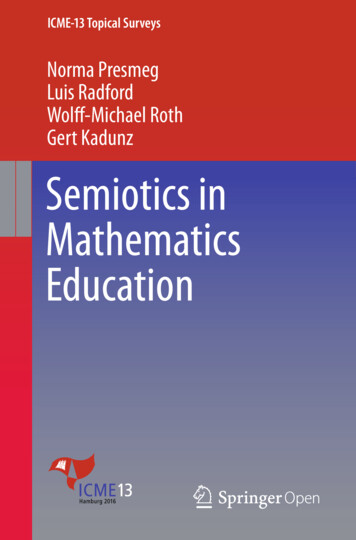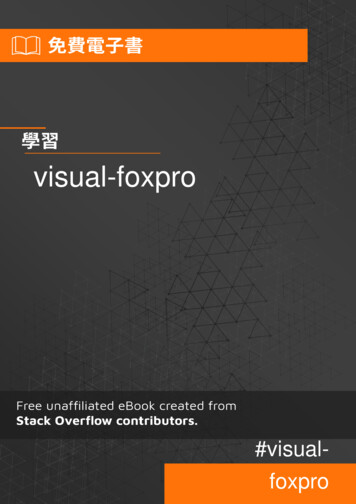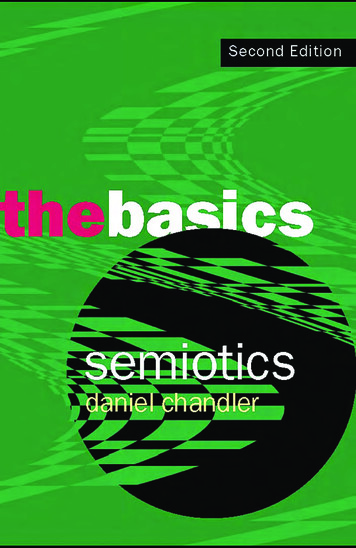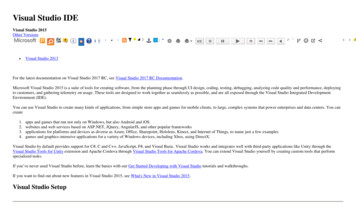
Transcription
Semiotics and Visual Communication:Concepts and Practices
Semiotics and Visual Communication:Concepts and PracticesEdited byEvripides Zantides
Semiotics and Visual Communication: Concepts and Practices,Edited by Evripides ZantidesThis book first published 2014Cambridge Scholars Publishing12 Back Chapman Street, Newcastle upon Tyne, NE6 2XX, UKBritish Library Cataloguing in Publication DataA catalogue record for this book is available from the British LibraryCopyright 2014 by Evripides Zantides and contributorsBook Cover design and copyrights by Theseas MouzouropoulosAll rights for this book reserved. No part of this book may be reproduced, stored in a retrieval system,or transmitted, in any form or by any means, electronic, mechanical, photocopying, recording orotherwise, without the prior permission of the copyright owner.ISBN (10): 1-4438-5468-9, ISBN (13): 978-1-4438-5468-9
to all the graphic warriors
TABLE OF CONTENTSList of Figures. xList of Tables . xiiPreface . xiiiAcknowledgements . xviiChapter One: Architectural and Spatial Design-Design for ThreeDimensional ProductsEmbedded, Introspective and Poetic Narratives in 3-Dimensional Design . 2Ralph BallHow Type Can Move Us—Type in the Environment: France . 11Jeff LeakDouble Writing in Architectural Design: A PhenomenologicalSemiotic Approach . 23Theodora PapidouChapter Two: Design for Print ApplicationsThe Renaissance of Academic Publishing: The Deconstructionof the Journal into a Pragmatic Manifestation of a PostmodernistSet of Discourses . 34Artemis AlexiouMarketing Semiotics Applied to the Design of Integrated GraphicCommunication Systems . 45Dora Ivonne Alvarez Tamayo(De)coding the Fabric of the European Years’ Visual Representations . 56Camelia Cmeciu and Doina Cmeciu
viiiTable of ContentsIntersemiotic Translation in Advertising Discourse: Plastic VisualSigns in Primary Function in Communication . 72Evangelos KourdisThe Greek-Cypriot Dialect in Writing: Orthographic Conventionsand Typographic Practices. 86Aspasia Papadima, Ioli Ayiomamitou and Stelios KyriacouChapter Three: Design for Screen Based MediaSigns at the Interface: An Exploration of Semiotics and InteractionDesign . 100Nikos BubarisLudic and Social Media Interaction Design Principles in Smart CityDevelopment . 110Patrick J. CoppockTypography and Language: A Semiotic Perspective . 126Jack PostFilm and New Art Media Semiotics: On the Figural . 139Irini StathiKinetic Typography: A Semiotic Exploration . 150Theo van Leeuwen and Emilia DjonovChapter Four: Pedagogy of Visual Communication100 Things: A Process for Foundation in Theory and Practice . 164Law AlsobrookVisual Diasporas: Comics as Transcultural Phenomena . 177Holger BrielThe Development of a Visual Literacy Course in Higher Education . 193Anastasia Christodoulou and George Damaskinidis“My First Experiment” “My First Ex”: A Multimodal Tool Proposedin the Didactics of Literature . 207Symeon Degermentzides
Semiotics and Visual Communication: Concepts and PracticesixDeveloping Students’ Visual Design Competence through SituatedLiteracy Practices: The Case of the Erasmus IP “P.S.BoWMa” . 224Catherine Dimitriadou and Androniki GakoudiThe Quest for “Visual Thinking” and the Double Bind of Education . 239Miltos FrangopoulosProject My City My Place: A Cross-Cultural Collaboration in GraphicDesign . 256Maryam HosseinniaThe Receiver is the Message? . 269Peter C. JonesA Course in Visual Communication . 284Tony PritchardChildren Are Painting Inscriptions: Pedagogy of Visual Communicationin Local History . 295Evangelia Svirou, Ifigeneia Vamvakidou and Paraskevi GoliaChapter Five: Visual ArtsMarks, Signs and Images: The Sense of Belonging and Commitmentwhich Pre-Dates History but has now become a Powerful GlobalLanguage . 310Paul MiddletonShowing Saying: On Speech Balloons . 322Lizzie RidoutContributors List . 332
LIST OF FIGURESFigure 1-1: Swan and Dolphin Hotels by Michael Graves/ Notch and TiltBest Supermarkets by SITEFigure 1-2: light and shade collectionFigure 1-3: the complete history of shelf supportsFigure 1-4: One Day I’ll design the Perfect Paper LampshadeFigure 1-5: power towerFigure 1-6: TransparentFigure 1-7: The removal of the billboard has left this sign visible behindthe later poster frameFigure 1-8: This gable end shows four advertising messages all overlaidand revealed by the passage of timeFigure 1-9: These two signs for the alcohol brand Suze were photographedin different parts of France and go someway to illustrating the visualdifferences that painted signs wrought on brand marksFigure 1-10: Space of inscription: it is circumscribed by doublewriting and geo-graphy.Figure 1-11: Architectural design as semiosis.Figure 2-1: Snapshot fromTalk to Her by Pedro AlmodovarFigure 2-2: Camera Obscura: feminism, culture and media studiesFigure 2-3: Camera Obscura: feminism, culture and media studiesFigure 2-4: Stages of the design processFigure 2-5: Logos of European YearsFigure 2-6: Print advertising of Cyprus BankFigure 2-7: Print advertising of the Greek mobile network operatorCosmoteFigure 2-8: Print advertising of Piraeus BankFigure 2-9: Consonants-vowels representation in words with the samemeaning, both in GC and SMG.Figure 2-10: Motifs created by the counter-forms of characters in GCFigure 2-11: How young people write in GCFigure 3-1: The opening screen of the Ermou Street multimediaapplicationFigure 3-2: Activating interactive objectsFigure 3-3: Smart City promotion images from three incidentally selectedweb sites
Semiotics and Visual Communication: Concepts and PracticesxiFigure 3-4: Connotative systemFigure 3-5: Nameplate Le MondeFigure 3-6: Four different realisations of the letter dFigure 3-7: Triadic sign modelFigure 3-8: SaussureFigure 3-9: A conceptual and a narrative imageFigure 4-1: 100 ThingsFigure 4-2: An example of word :: image :: image :: wordFigure 4-3: Student critiquing another student’s workFigure 4-4: Final poster examples from 100 ThingsFigure 4-5: Teaching scenario a comparison between Florina and BitolaFigure 4-6: The teaching scenario ArcturosFigure 4-7: The teaching scenario Christian Orthodox Religious symbolsin PrespesFigure 4-8: Statement of the Eames Design Process by Charles EamesFigure 4-9: Laszlo Moholy-Nagy: Visual Representation of the novelFinnegans Wake by James Joyce,Figure 4-10: Grammar as “memory image” and “object alphabet” fromJohannes RomberchFigure 4-11: AUK. Male Kuwaiti student, age 29Figure 4-12: MSUM Male American student, age 22Figure 4-13: AUK. Female Kuwaiti student, age 19Figure 4-14: MSUM. Female American student, age 20Figure 4-15: The research proposition as an example of the eclectic andindeterminate nature of the Design process.Figure 4-16: GroupingFigure 4-17: DensityFigure 4-18: The T-ness of TFigure 4-19: Typographic hierarchy exerciseFigure 4-20: A Vyzantis signFigure 4-21: A children's sign-The doctorsFigure 4-22: A children's sign–VOLT, a sport shopFigure 5-1: Tag created in The Graffiti Creator applicationFigure 5-2: Catherine Middleton’s (Duchess of Cambridge) coat of armsFigure 5-3: Catherine Middleton’s (Duchess of Cambridge) coat of armsFigure 5-4: This Nike advertisement is a clear reference to the nativity starFigure 5-5: Greenpeace’s ‘rebranded’ BP symbolFigure 5-6: Soliloquy [After Bakhtin]Figure 5-7: Soliloquy [After Bakhtin]Figure 5-8: Compilation of pages from Ways to talk and yet say nothing,or ways to not talk and yet say everything
LIST OF TABLESTable 2-1: The cognitive flow beyond the European Years’ logosTable 2-2: Type visual deontic modalityTable 2-3: Token visual deontic modalityTable 4-1: An overview of the structure of the courseTable 4-2: Multimodal factorsTable 4-3: The semiotic practices comprising the IP P.S. BoWMa withinthe concept of “design”Table 4-4: Inventory of the resources used for the compilation of theteaching scenarios
PREFACEThis book is the result of selective research papers that were presented atthe first international conference of Semiotics and Visual Communicationat the Cyprus University of Technology in November 2011. Theconference was built around the theme from theory to practice and broughttogether researchers and practitioners who study and evaluate the waysthat semiotic theories can be analysed, perceived and applied in thecontext of various forms in visual communication. Within a Semioticframework, the book explores research questions under five main thematicareas: Architectural and Spatial Design-Design for Three-DimensionalProducts, Design for Print Applications, Design for Screen-Based Media,Pedagogy of Visual Communication and Visual Arts. It investigatesSemiotics, not only from a theoretical and historical perspective, but alsofrom an applied point of view, looking at how theory can be implementedinto design and visual communication practice. A key feature of the bookis the diversity of 25 essential contributions by 33 academics andpractitioners that display their concepts and ideas on Semiotics within theinterdisciplinary nature of Visual Communication. From Plato’s Cratylusto structuralism and post-structuralism, the presence and aspects ofSemiotics as defined by linguists, have always been strongly present andapplied in non-verbal languages. The selected authors that follow are aproof of the fascinating research and design opportunities that constantlyemerge and enrich, at the same time, visual communication.Ralph Ball is concerned with the generation of artefacts, whichdeconstruct and reconstruct design axioms and ideologies. He presents anevolving series of conceptual artefacts, which act as visual reflections onModern, Postmodern and Contemporary design culture, as well as reexamines typologies and generic forms with reference to the rhetoricalthemes and axioms specific to Modernism. Jeff Leak successfullyjuxtaposes parallels between the caves of Lascaux and the old paintedroadside advertising that decorates the roadside in France. He suggests thatthe simplicity of their temporally altered messages implies a different kindof social interaction; a more civilised societal code and explores theirFrenchness from a semiotic perspective. Theodora Papidou investigatesthe moment of first retaining an intention in lines and words during theprocess of architectural design as ushers in the activation of a mechanism,
xivPrefacefixing architectural thought in iconic and verbal signs. She looks at thetraces of this first instance of retaining up to the emergence of form andconcept, as well as the text of the special design writing to be regarded as aunit of signification. Artemis Alexiou re-examines the design and layoutof academic print journals in order to reflect the nature of contemporaryacademic discourse more, as well as introduce a concentrated designconceptualisation and production into the sphere of academic journals toimprove their visibility and promote academic ideas to a wider audiencebeyond the academic communities. Dora Ivonne Alvarez Tamayofocuses on the production of discursive systems aimed at promoting thebrand positioning through the articulation of visual messages that areissued in different media, by which an organisation, company or productuses to contact their users. Camelia Cmeciu and Doina Cmeciucollaborate on the deep structure of unity with the EU communicationcampaigns for promoting European Years, common to all the memberstates, and look at their diversity with the implementation of the issues ofeach European Year within public communication campaigns of differentmember states’ organisations. Evangelos Kourdis presents selected casesof intersemiotic translation in advertisements adopting Groupe μ.’ s (1992)approach and he examines Greek examples whose intersemiosis is basedprimarily on the interpretation of the verbal system by plastic visualsystems that co-exist with iconic visual signs. Aspasia Papadima, IoliAyiomamitou and Stelios Kyriacou investigate issues related to theinterplay of typography and orthography design for a non-codified dialect.They engage in researching the orthographic representation of the nonstandard Greek-Cypriot dialect spoken by the Greek-Cypriots in Cyprus.Nikos BubarisI explores Semiotics and Interaction Design by proposing asynthetic model of four communicative functions of user-interface signs:modes of remediation, action-oriented representations, nodes ininformation maps and computational effects by reference to a multimediaapplication that a team of students produced as an assignment. Patrick J.Coppock focuses on how “ludic and social media interaction designprinciples” may be useful for mapping, planning, designing and realisingpeople-friendly urban spaces in Smart(er) Cities. Jack Post proposes thattypography can be considered as a poetical or aesthetic language thatsubverts the primary functions of the alphabet and written language. Herecommends that a semiotics of typography is possible, and can beapproached as a secondary poetic organisation of the planar writtensurface. Irini Stathi indicates that the heterogeneity and complexity ofmultimodal coded texts probably require new semiotic concepts and likelynew methods of research in order to delineate the role of the figural in the
Semiotics and Visual Communication: Concepts and Practicesxvscreen-based arts’ signification. Theo van Leeuwen and Emilia Djonovexplore kinetic typography as a fundamental change in the semioticlandscape and investigate the potential meaning of this new semioticmode, what we can ‘say’ with it and how, as well as how this potentialmeaning comes about. Law Alsobrook unpacks some of the methods andmeans by which teaching sophomores the language of design is takingplace, while they explore the design process. Holger Briel looks at comicsas transcultural phenomena and analyzes how graphic novels can becomeeffective teaching tools by investigating common challenges that comefrom students themselves. Anastasia Christodoulou and GeorgeDamaskinidis examine how literacy can be practised when analysingvideo as a new form of multimodal text. By employing this new concept ofpedagogy, they aim to introduce a framework to describe the activities ofindividuals as they identify, read and create new texts using varioussemiotic codes. Symeon Degermentzides proposes an educational softwarethat aims to register information about the choices a student makesconcerning meaning-making resources, while surfing on the Internet.Catherine Dimitriadou and Androniki Gakoudi explore the ways thatsituated literacy practices can contribute to the development of studentteachers’ semiotic awareness and their competence as educational agents.Miltos Frangopoulos negotiates the quest for “visual thinking” and thedouble bind of Education so as to assist students to move beyond meretransmission or ‘communication production’, towards invention, confrontingthe more significant issues related to the authorship of meaningfulproposals. Maryam Hosseinnia looks at cross-cultural collaboration indesign learning and she uses the semiotic approach to analyse, process andinterpret messages/signs to understand their meaning and their influenceon people’s interpretation in different parts of the world. Peter C. Jonesoutlines the early stages of a practice-based PhD into the effect oncommunication design methodologies and outputs, by substitutingestablished types of market segmentation with theories and categories usedby teachers to identify the styles or models by which people learn. TonyPritchard presents a Visual Communication course from the LondonCollege of Communication that its postgraduate design sets out todemystify the theories and practices of visual communication. Throughthe presentation of a case study, he aims to show how semiotics andrelated theories are applied in a practical learning and teaching context.Evangelia Svirou, Ifigeneia Vamvakidou and Paraskevi Golia outlinethe outcome of a didactic proposal for children who learn about localhistory. Their theory and analysis are based on “reading” students’products using social semiotics within the scope of visual communication.
xviPrefacePaul Middleton explores the emergence of primitive marks as signswhich identified people long before a verbal language emerged. He buildson them as marks that followed a different evolutionary path, suggestingthat they communicate with simplicity and economy; conveying far morethrough simple juxtaposed images than a complex series of words. LizzieRidout brings together theoretical, historical and practice-based researchto examine the semiotic aspects of speech balloon. In part, she outlines acollection of ruminations, preoccupations, truths and tales examining thespeech balloon and its dear, yet distinct relative, the thought balloon.Taking this publication as a starting point for action, combined withthe constitution of Cyprus Semiotics Association in 2013 and the supportof the Hellenic Semiotic Society, Cyprus begins to have a place on theinternational Semiotic map. I hope you enjoy this book and find itstimulating and useful in providing some answers on putting semiotictheory into visual communication practice.Evripides ZantidesLemesoswww.svclab.com
ACKNOWLEDGEMENTSThis book, as a result of the first International Conference on Semioticsand Visual Communication that was held in Cyprus in November 2011,would not have been possible without the contribution and help of itsscientific and organising committees, reviewers, speakers and volunteerswho were involved throughout its process and accomplishment.Special thanks must go to Savvas Christodoulides, AnastasiaChristodoulou, Antonis Danos, Miltos Frangopoulos, Matthew Hobson,Marianna Kafaridou, Evangelos Kourdis, Alexandros Ph. Lagopoulos, JeffLeak, Theo van Leeuwen, Paul Middleton, Arafat Al Naim, GrigorisPaschalidis, Marios Phocas, Ifigeneia Vamvakidou and Lia Yoka. Manythanks also to Monika Herodotou, Eleftheria Iasonos, Christina Koutalis,Theseas Mouzouropoulos, Christina Nicolaou, Angelos Panayides,Aspasia Papadima, Ioanna Tymbiotou, Panayiotis Zaphiris for all theirsupport, as well as to the Department of Multimedia and Graphic Arts atthe Cyprus University of Technology, the Cyprus Tourism Organisation, design magazine, the vcdc-visual communication designer’s club, theHellenic Semiotics Society, the Semiotics and Visual Communication Labat Cyprus University of Technology, the Cyprus Semiotic Association,Cambridge Scholars Publishing and all my colleagues, friends andstudents who respond positively in the struggle for contribution tosemiotic knowledge, visual communication and graphic design practice.
CHAPTER ONE:ARCHITECTURAL AND SPATIAL DESIGN—DESIGN FOR THREE DIMENSIONALPRODUCTS
EMBEDDED, INTROSPECTIVE AND POETICNARRATIVES IN 3-DIMENSIONAL DESIGNRALPH BALLMy research is concerned with the generation of artefacts, whichdeconstruct and reconstruct design axioms and ideologies. The studiespresented in this paper form part of an evolving series of conceptualartefacts, which act as visual reflections on Modern, Postmodern andContemporary design culture. Typologies and generic forms characteristicof modern furniture and lighting are re-examined with reference to therhetorical themes and axioms specific to Modernism.Axiom examples typical of the modernist canon include the following:Form follows Function (L Sullivan), Less is More (L. Mies van de Rohe),Decoration and Crime (A. Loos) often misquoted and interpreted asDecoration is a Crime; Starting from Zero and Continuous Revolution(W.Gropius) and Truth to Materials (C. Brancusi). Themes considered andexamined include Transparency, Minimalism and Multifunctionality. Theaim of the visual re-examinations is to simultaneously challenge andaccommodate the above axioms in search of new, authentic forms ofvisual expression.Postmodernism, as understood with reference to design, challengedmodernism’s formal purity claiming that modernism’s rational abstractionlimits subjective and narrative expression. In ‘Complexity and Contradictionin Architecture’ (1), architect Robert Venturi famously paraphrased Miesvan de Rhoe’s modernist mantra of “Less is More” with “Less is a Bore”.Venturi’s historical architectural analysis called for a replacement ofmodernism’s reductive abstraction with an intelligent, richly diverse,symbolic form in a contemporary context. He called for inclusiveness andambiguity using terms like both-and rather than either–or. Whilst Venturiadvocated complexity and contradiction, he was opposed to the incoherentand the arbitrary in architectural expression. However, his intensions werevery often misinterpreted and corrupted and gave rise to much arbitraryand whimsical architecture: many so-called postmodern buildingsemployed an eclectic mix of architectural styles but often lacked anycoherent, conceptual underpinning.
Ralph Ball3Fig. 1-1 Swan and Dolphin Hotels by Michael Graves (top of this image) Beloware Notch and Tilt Best Supermarkets by SITEFor example, the arbitrary and decorative theatricality of the Swan andDolphin Hotels by Michael Graves (2) (at the top of this image) is, Isuggest, typical of postmodern architecture. Contrast this with the moreunusual, ‘conceptual theatricality’ of architecture by SITE for BestSupermarkets. (3) These buildings present the supermarket authenticallyas a commercially pragmatic, big, simple box. Acknowledging thelegitimacy of the big box allows entrances to be dramatically signified.Entrances are conceived and visually announced as inventive ways of‘opening’ the box.My research similarly intends to filter the rationality of the modernthrough the contradictions and complexities of the postmodern withoutloss of conceptual authenticity. In these studies, modernism’s rational andreductive axioms are reframed or pushed to logical extremes in order toendorse the paradox and legitimise the invention of formal incongruities,rational irrationalities or poetic transgressions. Ironic iconics: the piecesare self-consciously introspective and are intended to reflect uponthemselves and their inherent culture.The research studies presented use a method analogous to archaeology.The intention is to uncover ‘embedded’ visual potential. The aim is toexpand or reinforce meaning in products by introducing or revealing latentnarratives. Plausible forms are extrapolated in this manner by examining,and drawing from, a product’s formal, visual parameters and implicitcontexts. This process introduces the concept of ‘design poetics’. Designsare materialised in ways that go beyond their function or even theirsymbolism, and playfully or critically reflect on a cultural meaning.
4Embedded, Introspective and Poetic Narratives in 3-Dimensional DesignThis ‘archaeological’ method is used to reinvest appreciation of thatwhich becomes undervalued through familiarity. It intends to visuallyarticulate areas, which are unregarded, celebrating the generic rather thanthe specific: it intends to find the extraordinary in the ordinary, re-seeingobjects and functions as if for the first time: it intends to envision freshpossibilities in commonalties, to start with the given and find new ways ofexpressing this within and through the objects studied. The studies,therefore, involve the reconfiguration of familiar, archetypical products.These product types we have called ‘mature typologies’ and defined asobjects, which generally have an agreed consensus on basic form andapplication. With this definition as a point of base reference, we nowillustrate a series of visual studies together with their various rationales.Light and ShadeThe ‘Light and Shade’ series explores the formal relationship betweengeneric light bulb and lampshade. A reconfiguring of this relationshiptransforms the reading of the geometrically abstract form of the modernistlampshade, (a truncated cone) into a series of more specific concreteobjects and meanings. The truncated cone, a formally abstract containerof light, is turned into other, familiar container types. By reconfiguring therelationship of bulb to shade, the ‘light-shade’ can be variously read asfruit bowl, plant-pot, skirt or bucket. Each of these formal changes, in turn,explores further modernist reference.Fig. 1- 2 ‘light and shade collection’steel, stone, aluminium, glass, fabric various sizes 1997Ralph BallGolden DeliciousThe inverted truncated cone becomes a container. This generic container isthen more specifically identified by the choice of content. In the firstobject many light bulbs are piled into the container, over one single litbulb, turning the bulbs into metaphorical fruit and, by association, the
Ralph Ball5container into a fruit bowl. The bulb, originally only the source of light,when used here ‘en masse’, also becomes the diffuser or shade element.The original shade becomes a frame to hold the new diffuser in place.The configuration produces an elegant paradox with reference to themodernist axioms of Brancusi’s ‘truth to materials’, Mies van de Rhoe’s‘less is more’ and Adolph Loos’s ‘decoration and crime’. Here is theapparent conundrum. This artefact uses ‘pure’ form and material: the lightbulbs are generic (truth to materials). The elements are functional and usedefficiently: the bulb acts as both light source and light shade (conceptuallyless is more). Yet conversely, the result is excessive and decorative in thequantity of bulbs used and in their playful distribution. In effect, thisconstruct breaks the rule of Loos’s ‘decoration and crime’ whilstsimultaneously adhering to the ‘less is more’ and ‘truth to materials’values of Mies van de Rohe and Brancusi.GenerationsIn the second example called “Generations”, the container is, again, morespecifically identified by content. The truncated cone here contains avertical tube from the end of which sprout two dichroic reflectors. Theconfiguration turns these reflectors into metaphorical flowers and, byassociation, the container into a plant pot. Dichroic reflector bulbs areclearly a more recent generation of light source than the classic andgeneric ‘Edison’ bulb. The original term ‘light bulb’ was clearly coinedwith reference to its shape, resembling that of organic bulbs and tubers.In this construct, an upside down light-shade implies the containmentof the classic Edison bulb within the cone. From this ‘now potted’ Edisonbulb, newer generations emerge and flower. Here, again, Loos’sDecoration and Crime (variously misquoted but commonly interpreted as‘decoration is a crime’) is subverted despite using only the essential,unadorned elements of light making. The configuration is essentiallyfigurative rather than abstract.Task Light (Wall-washer)In this third example, the truncated cone is inverted again and hung onto aladder structure. This ladder frame, by association, turns the reading of thecone metaphorically into a window cleaner’s bucket. The aluminiumladder enables low voltage current to be conducted through the frame.This, in turn, allows the cone, now a ‘bucket of light’, to be lifted fromrung to rung and to relight on contact with each of the rungs.
6Embedded, Introspective and Poetic Narratives in 3-Dimensional DesignThe modernist preoccupation under examination here is ‘adjustability’.However, instead of the sophisticated adjustability of the angle poise,dimmer switch or multi-track lighting, adjustability is expressed here inone of the most fundamental forms. The light source can only be heightadjusted by the simple process of lifting it from rung to rung: a simple,visibly accessible, analogue process supported by a sophisticated andinvisible low voltage application.SwitchThe relationship of formal position is explored in the fourth object. Theconventional relationship in a freestanding standard lamp is clearly that theshade covers the bulb at the top of a supporting column. In this study, theshade is dropped to the ground, leaving the bulb unshielded. Anunshielded bulb is often referred to as a ‘naked’ light. The cone in thisground level position may now be perceived as a dropped or slipped skirt.The on/off positional relationship of skirt to bulb also acts as a switch for theelectrical on/off. The skirt may be moved from the ground back to coveringthe bulb. The physical and el
The Renaissance of Academic Publishing: The Deconstruction of the Journal into a Pragmatic Manifestation of a Postmodernist . Marketing Semiotics Applied to the Design of Integrated Graphic Communication Systems . 45 Dora Ivonne Alvarez Tamayo (De)coding the Fabric of the European Years' Visual Representations . 56 Camelia Cmeciu and .










